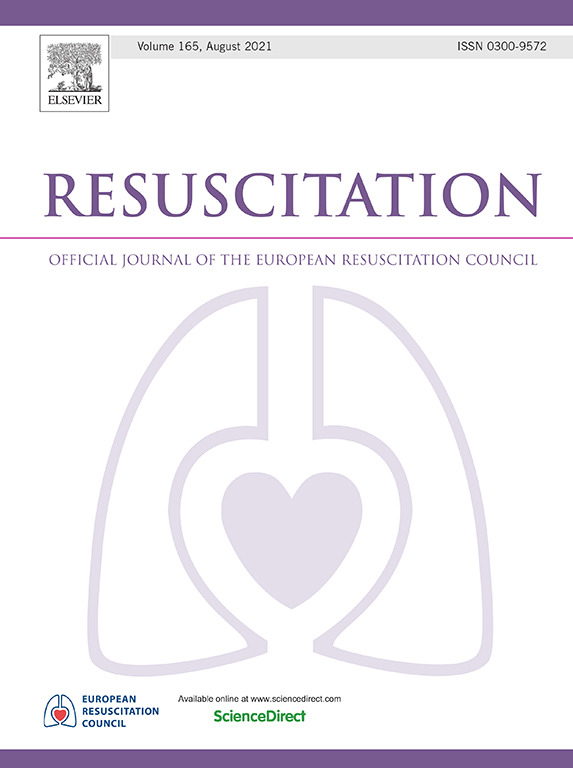Time-dependent association of grey-white ratio on early brain CT predicting outcomes after cardiac arrest at hospital discharge
IF 4.6
1区 医学
Q1 CRITICAL CARE MEDICINE
引用次数: 0
Abstract
Background
Cerebral edema after cardiac arrest can be quantified by the ratio of grey matter to white matter radiodensity (GWR) on computed tomography (CT). Severe edema predicts worse outcomes. We hypothesized the sensitivity and false positive rate of GWR predicting outcomes change over the first 24 hours post-arrest.
Methods
We performed a single-center retrospective cohort study including patients resuscitated from cardiac arrest between January 2010 and December 2023 who were unresponsive to verbal commands. We excluded patients who arrested from a primary traumatic or neurological etiology and those without brain imaging within 24 hours of arrest. We divided patients into groups based on time from arrest to CT, then quantified the performance of GWR dichotomized at <1.10 and <1.20, predicting in-hospital mortality and death by neurologic criteria (DNC).
Results
We included 2,204 patients with mean age 59 (SD 16) years. Overall, 1651 (75%) died in the hospital, of whom 248 (11%) progressed to DNC. Sensitivity of GWR <1.10 and GWR <1.20 for predicting in-hospital mortality increased over the first four hours post-arrest, reaching a maximum of 25% after five hours, while false positive rates remained <5% at all time points. Similar temporal trends were observed with DNC, although absolute values of sensitivity and false positive rate (FPR) varied.
Conclusion
The sensitivity and FPR of early GWR predicting in-hospital mortality and DNC after resuscitation from cardiac arrest varies over the initial post-arrest period. Reduced GWR on brain CTs is most sensitive for in-hospital mortality when obtained more than four hours post-arrest and for DNC when obtained between four and five hours. However, FPR remained execellent throughout, making early reductions in GWR a specific marker of poor outcome regardless of timing. While brain CTs obtained within the first 24 hours post-arrest may be indicated to evaluate for neurologic etiologies of arrest, they may be less informative as an independent marker of prognosis.
早期脑 CT 灰白比与心脏骤停出院后预后的时间相关性。
背景:心脏骤停后的脑水肿可通过计算机断层扫描(CT)上灰质与白质放射密度(GWR)之比进行量化。严重水肿预示着较差的预后。我们假设 GWR 预测预后的灵敏度和假阳性率在心跳骤停后的 24 小时内会发生变化:我们进行了一项单中心回顾性队列研究,研究对象包括 2010 年 1 月至 2023 年 12 月间心脏骤停复苏后对口头指令无反应的患者。我们排除了因原发性创伤或神经系统病因而心跳骤停的患者,以及在心跳骤停后 24 小时内未进行脑成像的患者。我们根据患者从心跳停止到进行 CT 检查的时间将其分为几组,然后量化了 GWR 在结果时的二分法性能:我们共纳入了 2,204 名患者,平均年龄为 59 岁(SD 16)。共有 1651 人(75%)在医院死亡,其中 248 人(11%)进展为 DNC。GWR < 1.10 和 GWR < 1.20 预测院内死亡率的灵敏度在心跳骤停后的头四个小时内有所上升,五个小时后达到 25% 的最高值,而假阳性率仍为结论:早期 GWR 预测院内死亡率和心脏骤停复苏后 DNC 的灵敏度和 FPR 在心跳骤停后的最初阶段有所不同。在心跳骤停后四小时以上和四至五小时之间,脑 CT 的 GWR 降低对院内死亡率的敏感度最高,对 DNC 的敏感度也最高。然而,在整个过程中,FPR始终保持拮抗状态,这使得GWR的早期降低成为不良预后的特异性标志,而与时间无关。虽然在心跳骤停后 24 小时内进行的脑 CT 可用于评估心跳骤停的神经系统病因,但作为预后的独立指标,其信息量可能较小。
本文章由计算机程序翻译,如有差异,请以英文原文为准。
求助全文
约1分钟内获得全文
求助全文
来源期刊

Resuscitation
医学-急救医学
CiteScore
12.00
自引率
18.50%
发文量
556
审稿时长
21 days
期刊介绍:
Resuscitation is a monthly international and interdisciplinary medical journal. The papers published deal with the aetiology, pathophysiology and prevention of cardiac arrest, resuscitation training, clinical resuscitation, and experimental resuscitation research, although papers relating to animal studies will be published only if they are of exceptional interest and related directly to clinical cardiopulmonary resuscitation. Papers relating to trauma are published occasionally but the majority of these concern traumatic cardiac arrest.
 求助内容:
求助内容: 应助结果提醒方式:
应助结果提醒方式:


